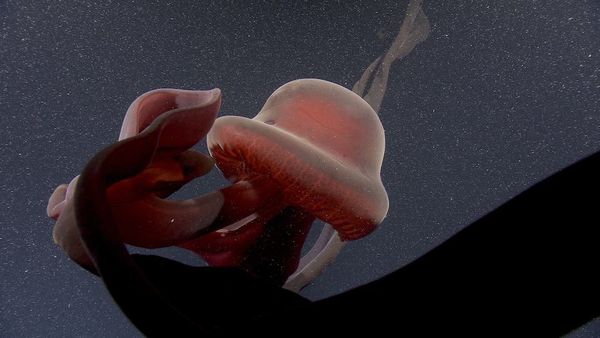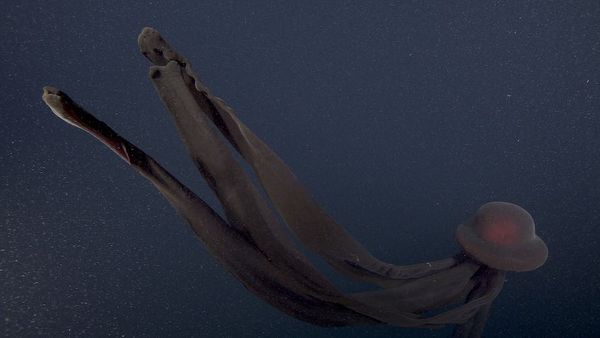
標題: [新聞] 百年僅發現100次!「冥河水母」深海現蹤 超巨體型讓專家驚艷 [打印本頁]
作者: itsctsu 時間: 2021-12-9 09:17 PM 標題: 百年僅發現100次!「冥河水母」深海現蹤 超巨體型讓專家驚艷
本帖最後由 itsctsu 於 2021-12-9 09:19 PM 編輯

▲美國研究團隊意外在水深975公尺處發現罕見的冥河水母。(圖/翻攝自MBARI官網,下同)
實習記者黃品臻/綜合報導
神秘的海洋中,仍有許多人類不了解的生物,甚至還存在未知的物種。美國有研究團隊近日在探查蒙特利灣附近海域時,竟意外捕捉到一隻巨大冥河水母悠游的身影,由於牠們生活在極深的海域,在過去122年來僅有約100次的目擊紀錄,是非常珍貴的發現。
綜合外媒報導,加州的蒙特利灣水族館附設研究所(MBARI)日前使用遙控潛水器(ROV)探查附近海域時,在約990公尺深處發現不明震動,沒想到前去調查後,相機竟捕捉到一隻相當罕見的冥河水母(Stygiomedusa Gigantea)在水中悠游,牠的直徑超過3.3英尺(約1公尺),並拖著長達33英尺(約10公尺)的帶狀「手臂」,釋出的影片中牠隨著海流漂動的畫面相當壯觀、唯美。
研究團隊表示,冥河水母在1899年首次被發現,但一直到1959年科學家們才承認牠是一個新物種,且從首次發現至今,科學家們也只遇到這種巨型水母約100次,即使是現在,人類對於這種生物的了解也很少。

▲冥河水母是地球上最巨大的水母之一。
儘管冥河水母在除了北極以外的所有海域都已有發現紀錄,但由於牠們可以下降到6000公尺以上的深度,即使有無人攝影器材的幫助,也很難捕捉到牠們的身影。蒙特利灣水族館附設研究所也在聲明中提到,過去34年的海洋研究、探查中,也只有過9次目擊冥河水母的記錄。
據《國家地理》報導,冥河水母是地球上最巨大的水母之一,與其他水母不同,牠們沒有帶刺觸手,取而代之的是可以長到超過10公尺的4條帶狀「手臂」,並用這些手臂來捕捉獵物進食,雖然沒有明確證據,但海洋生物學家認為牠們以浮游生物和小魚為食。
An extraordinary deep-sea sighting: The giant phantom jelly
[youtube]9bzQYKm3xTA[/youtube]
This ghostly giant is a rare sight. But in November 2021, MBARI researchers spotted this giant phantom jelly (Stygiomedusa gigantea) with the ROV Doc Ricketts 990 meters (3,200 feet) deep in Monterey Bay. The bell of this deep-sea denizen is more than one meter (3.3 feet) across and trails four ribbon-like oral (or mouth) arms that can grow more than 10 meters (33 feet) in length. MBARI’s ROVs have logged thousands of dives, yet we have only seen this spectacular species nine times.
The giant phantom jelly was first collected in 1899. Since then, scientists have only encountered this animal about 100 times. It appears to have a worldwide distribution and has been recorded in all ocean basins except for the Arctic. The challenges of accessing its deep-water habitat contribute to the relative scarcity of sightings for such a large and broadly distributed species.
Historically, scientists relied on trawl nets to study deep-sea animals. These nets can be effective for studying hardy animals such as fishes, crustaceans, and squids, but jellies turn to gelatinous goo in trawl nets. The cameras on MBARI’s ROVs have allowed MBARI researchers to study these animals intact in their natural environment. High-definition—and now 4K—video of the giant phantom jelly captures stunning details about the animal’s appearance and behaviors that scientists would not have been able to see with a trawl-caught specimen.
| 歡迎光臨 公仔箱論壇 (http://5.39.217.77/) |
Powered by Discuz! 7.0.0 |


